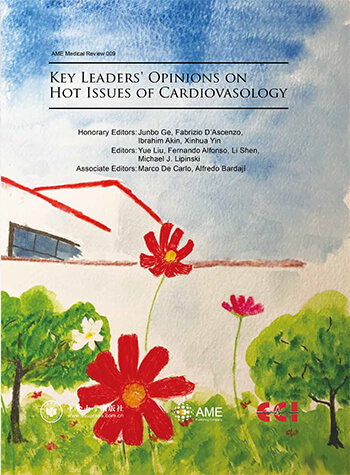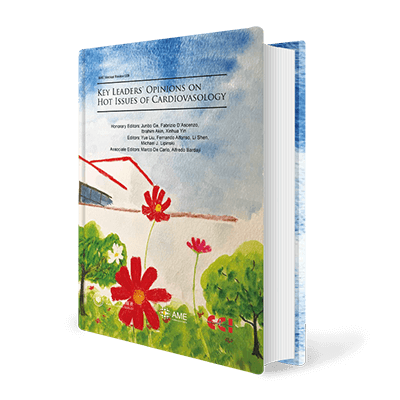
Key Leaders' Opinions on Hot Issues of Cardiovasology
| Editors: | Yue Liu, Fernando Alfonso, Li Shen, Michael J. Lipinski |
Publisher: AME Publishing Company; 1st edition (2017)
ISBN-13: 978-9887784074
Hardcover: 218 pages
Language: English
All authors contributed in this edition are key opinion leaders in their specialties with extensive experience. They are encouraged to fully share their insightful comments on the most updated researches published on top-ranked journals, which covers the most important studies, understandings and updates on cardiovasology. Divided into different sections, this book covers a wide spectrum of current hot topics that are relevant to new techniques, methods and treatments in the field: ST-Segment Elevation Myocardial Infarction, Absorb Bioresorbable Vascular Scaffold, Percutaneous Coronary Interventions In Chronic Total Occlusion, Coronary In-Stent Restenosis, Atrial Fibrillation and Left Atrial Appendage Closure, Percutaneous Left Ventricular Assist Device, etc. These topics are thought-provoking, and worth being further discussed and addressed.
Honorary Editors
| Junbo Ge | Department of Cardiology, Shanghai Institute of Cardiovascular Diseases, Zhongshan Hospital, Fudan University, 180 Fenglin Road, Shanghai, 200032, China |
| Fabrizio D’Ascenzo | Dipartimento di Scienze Mediche, Divisione di Cardiologia, Città della Salute e della Scienza, Turin, Italy |
| Ibrahim Akin | First Department of Medicine, University Medical Centre Mannheim (UMM), Faculty of Medicine Mannheim, University of Heidelberg, Theodor-Kutzer-Ufer 1-3, 68167, Mannheim, Germany |
| Xinhua Yin | Department of Cardiology, The First Af liated Hospital of Harbin Medical University, No. 23, YouZheng Street, NanGang District, Harbin, 150001, Heilongjiang, China |
Editors
| Yue Liu | Department of Cardiology, The First Af liated Hospital of Harbin Medical University, No. 23, YouZheng Street, NanGang District, Harbin, 150001, Heilongjiang, China |
| Fernando Alfonso | Cardiology Department, Hospital Universitario de La Princesa, Instituto de Investigación Sanitaria, IIS-IP, Universidad Autónoma de Madrid, calle Diego de León 62, Madrid 28006, Spain |
| Li Shen | Department of Cardiology, Shanghai Institute of Cardiovascular Diseases, Zhongshan Hospital, Fudan University, 180 Fenglin Road, Shanghai, 200032, China |
| Michael J. Lipinski | MedStar Heart and Vascular Institute, MedStar Washington Hospital Center, 110 Irving St NW, Washington DC 20010, USA |
Associate Editors
| Marco De Carlo | Cardiac Catheterization Laboratory, Cardiothoracic and Vascular Department, Azienda Ospedaliero-Universitaria Pisana, Pisa, Italy |
| Alfredo Bardají | Servicio de Cardiología, Hospital Universitario de Tarragona Joan XXIII, Calle Dr Mallafré Guasch 4, Tarragona 43007, España |
Table of Content
Foreword
Preface
ST-Segment Elevation Myocardial Infarction
1 Clinical perspective of optical coherence tomography and intravascular ultrasound in STEMI patients
4 Aspiration thrombectomy in 2015: a TOTAL defeat?
8 When clinical experiences clashes against evidence based medicine: the case of aspiration thrombectomy in primary percutaneous coronary intervention (PCI)
11 Therapeutic hypothermia in ST elevation myocardial infarction (STEMI): a long way to go
14 Therapeutic hypothermia in ST-elevation myocardial infarction (STEMI): targeting the appropriate STEMI
17 Dual antiplatelet therapy duration after drug-eluting stents: how long?
20 Prolonged dual antiplatelet therapy in renal failure: a challenging trade-off
24 Time for science to catch up with clinical practice?
Absorb Bioresorbable Vascular Scaffold
28 Bioresorbable drug eluting scaffolds—are bioresorbable stents ready for today’s clinical practice?
31 Bioresorbable vascular scaffolds in patients with acute myocardial infarction: a new step forward to optimized reperfusion?
38 Bioresorbable vascular scaffolds—time to vanish?
44 Overlapping meta-analyses of bioresorbable vascular scaffolds versus everolimus-eluting stents: bringing clarity or confusion?
49 Bioresorbable vascular scaffolds—what does the future bring?
54 Bioresorbable scaffold—the holy grail of percutaneous coronary intervention: fact or myth?
Percutaneous Coronary Interventions in Chronic Total Occlusion
58 Predictive scores in chronic total occlusions percutaneous recanalization: only fashionable or really useful?
63 Scoring systems for chronic total occlusion percutaneous coronary intervention: if you fail to prepare you are preparing to fail
67 Chronic total improvement in ventricular function and survival
71 The impact of percutaneous coronary intervention of chronic total occlusions on left ventricular function and clinical outcomes
75 Chronic total occlusion: no more meta-analysis, please—a randomized clinical trial is urgently needed
78 Meta-analyses and randomized trials investigating percutaneous coronary intervention of chronic total occlusions: what is left to explore?
Coronary In-Stent Restenosis
81 Five factors and three characteristics of coronary in-stent restenosis
84 Mechanism of in-stent restenosis after second-generation drug-eluting stents (DES): is it different from bare-metal stents and rst-generation DES?
88 Use of intravascular ultrasound vs. optical coherence tomography for mechanism and patterns of in- stent restenosis among bare metal stents and drug eluting stents
93 In-stent restenosis and thrombosis due to metal hypersensitivity: implications for Kounis syndrome
96 Contemporary drug-eluting stents and companion polymers: durable is not synonymous with harm
99 Treatment of coronary in-stent restenosis—evidence for universal recommendation?
103 Treatment for in-stent restenosis: patient-speci c decision rather than universal recommendation
106 In-stent restenosis: local drug delivery with a stent or balloon?
108 Network meta-analyses on in-stent restenosis treatment: dealing with complexity to clarify ef cacy and safety
114 Optimal interventional strategy for the treatment of coronary in-stent restenosis
Atrial Fibrillation and Left Atrial Appendage Closure
117 The appropriate use of risk scores in the prediction of atrial brillation
121 A meta-analysis of left atrial appendage closure for stroke prevention in atrial brillation—adding to the debate but elements remain unresolved
125 The case of stroke prevention by left atrial appendage occlusion in patients with atrial brillation—can we close the file?
128 Left atrial appendage exclusion for atrial brillation: does the protection from stroke prevail in the long- term?
136 Five years of keeping a watch on the left atrial appendage—how has the WATCHMAN fared?
144 Percutaneous left atrial appendage closure: here to stay
Percutaneous Left Ventricular Assist Device
148 High risk percutaneous coronary interventions—signi cance of left ventricular assist device for clinical practice
151 Percutaneous left ventricular assist device in high risk percutaneous coronary intervention
Revascularization strategy and Coronary Artery Disease
156 Shedding light on the gray zone
160 The fractional ow reserve gray zone has never been so narrow
163 Very long-term follow-up for left main coronary artery stenting: a missing piece of the jigsaw puzzle
167 Completeness of revascularization in multivessel coronary artery disease
171 To complete, or not to complete, that is the question of revascularization in percutaneous coronary intervention with drug-eluting stents for multivessel disease
Anti-coagulation and Pulmonary Arterial Hypertension
177 Where do we go from here? Reappraising the data on anticoagulation in pulmonary arterial hypertension
184 Registry to evaluate early and long-term disease management in PAH (REVEAL)
187 Anti-coagulation in pulmonary arterial hypertension: the real blood and guts
Acute Hyperglycemia and Vascular Homeostasis
189 Effects of acute hyperglycaemia on cardiovascular homeostasis: does a spoonful of sugar make the ow- mediated dilatation go down?
194 Hyperglycemic endothelial dysfunction: does it happen and does it matter?
197 Acute hyperglycemia impairs ow-mediated dilatation through an increase in vascular oxidative stress: winter is coming for excess sugar consumption
Aortic Regurgitation and Valvular Cardiomyopathy
200 Wave mice: a new tool in the quest to characterize aortic valvular disease etiologies
203 Aortic regurgitation and heart valve disease in mice
Statin Therapy in Heart Failure
205 Statin therapy for heart failure: to prescribe or not?
207 The use of statins in patients with heart failure: more questions than answers
Hypothyroidism and Percutaneous Coronary Intervention
211 Major adverse cardiovascular and cerebral events in hypothyroid patients undergoing percutaneous coronary intervention
214 Evidence and controversies regarding the screening for subclinical hypothyroidism in patients with cardiovascular disease



